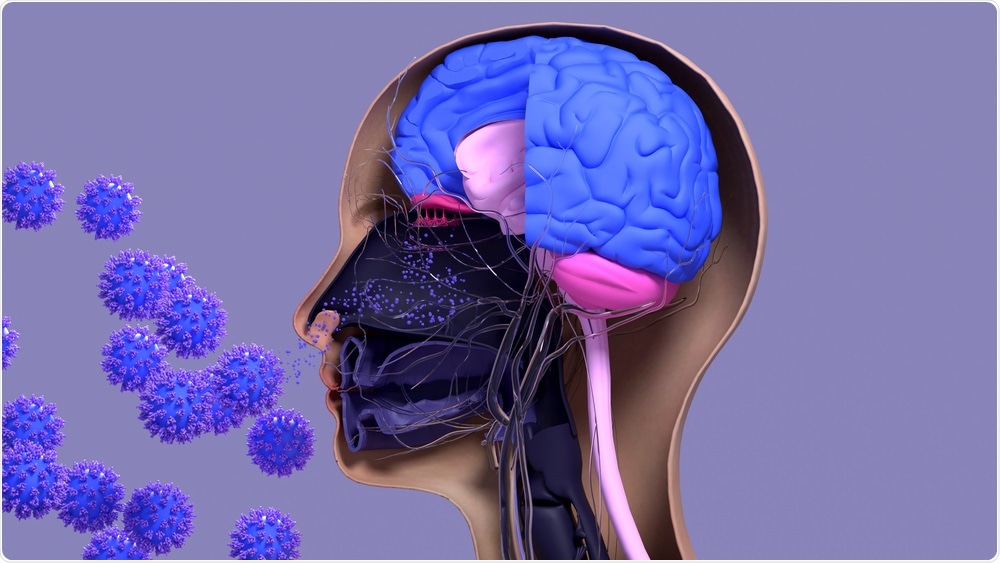SARS-CoV-2 infection is typically mild in children, including infants, both term and preterm. This is paradoxical since they are usually at greater risk from infections, whether bacterial or viral.
Vertical transmission from mother to fetus is also very rare in cases of maternal SARS-CoV-2 infection. These phenomena have been attributed to a low frequency of host cell receptors such as the angiotensin-converting enzyme 2 (ACE2), which mediates viral entry, in the epithelium of the airway in children compared to adults.

Nasal System. Image Credit: Design_Cells/Shutterstock.com
Study aims
The current study focused on measuring the level of expression of messenger ribonucleic acid (mRNA) transcribing the genes that encode these receptors. These include ACE2, as well as transmembrane serine protease 2 (TMPRSS2), and neuropilin 1 (NRP1), and neuropilin 2 (NRP2).
These are all factors that act in cooperation to mediate the entry of ACE2 into the host cells. The study also included the measurement of the expression of mRNA for insulin-like growth factor one receptor (IGF1R), a molecule that mediates the effects of a vital entry factor for the respiratory syncytial virus (RSV).
The study included 28 newborns, 17 of them having been born at term. Nasal epithelium samples were collected and the expression of these receptors was assessed using qRT PCR.
What were the findings?
The researchers found that the expression of four of the five receptors was different in newborn babies at 24 hours after birth, compared to adults. That is, newborn babies, whether term or preterm, had markedly lower levels of expression of the genes encoding ACE2, TMPRSS2, NRP1, and NRP2 genes compared to adults.
When it comes to IGF1R, the expression of this gene was much less only in term neonates compared to adults. In none of the genes was there any significant difference between term and preterm newborns.
The findings show that adults have a higher abundance of mRNA encoding the two receptor molecules, ACE2 and TMPRSS2, than in newborn infants, whether born at term or preterm. In addition, the cofactors NRP1 and NRP2 required for viral entry via the ACE2 receptors are also expressed at higher levels in adults.
The low levels of these molecules in infants at this time may account, at least in part, for the low rate of viral transmission from infected mothers to the fetus or newborn. Moreover, this may also explain why severe infection is rare in this age group.
Another earlier study showed low levels of ACE2 in nasal samples from children aged 4-10 years as compared to adults.
TMPRSS2 levels also show an age-dependent increase and are therefore lower in children. This enzyme is responsible for activating or priming the viral spike protein, which facilitates viral fusion to the cell membrane and cell entry. This study is the first to demonstrate lower TMPRSS2 expression in newborns.
No additional risk in preterm infants
Since preterm birth is known to be more common following maternal SARS-CoV-2 infection, the findings that preterm infants have comparable levels of entry receptors as term infants indicate that they are not at additional risk for infection from the infected mother.
Taken together, these findings suggest that preterm infants may be less susceptible to severe COVID-19 than to many other infections and carry risk comparable with term newborns.”
Caveats
The study was a very small one, with less than 30 newborn infants. Secondly, the researchers analyzed only gene expression rather than protein expression and thus may have missed any post-transcription regulation of the receptors.
Thirdly, it is possible that they measured both functional and truncated non-functional forms of ACE2, leading to a falsely high level of expression of this receptor, compared to the actual abundance. The latter isoform is induced by viral infections, probably by interferon, and these receptors do not bind to SARS-CoV-2. However, the measurement of the total number of isoforms may not have adversely impacted the results of the study, as all the newborn infants in this study showed no signs or symptoms of COVID-19.
What is the conclusion?
This study indicates that expression of SARS-CoV-2 entry receptors in the nasal epithelium of term and preterm newborns is lower compared with adults. This may contribute to low transmission rates and lack of severe SARS-CoV-2 infection in newborns, but further studies are warranted.”